Finding flow in a challenging recipe
By Frank Whitman
Once in a while I crave a good cooking project – something that will be as absorbing as a jigsaw puzzle, a crossword or a craft, but with a delicious result. It could be a complicated multi-part cake, a yeast bread with its magical rise, or an elaborate dinner presentation.
Any one of these can induce the kind of flow where the aggravations of daily life fade away. Just ask Marsha how hard it is to get my attention while I’m trying to grasp the numerous recipe steps or the mysteries of time and temperature. She claims I don’t hear her (and she’s often right.)
Although the cooking-project impulse can come on in any season, it’s more likely in Winter when the days are short and outdoor activities are curtailed. For me, New Year’s with its celebratory meals is a prime candidate. Pushing back the Christmas hullabaloo and focusing on a complex kitchen activity is a great start to the new year.
Beef Wellington seemed the ideal centerpiece for a gathering of six to bid farewell to 2023. Festive and “special” it appealed to all the invited guests. For me, it was an opportunity to delve into meat cutting, pastry handling, tricky timing and a mysterious concoction called duxelles – all challenges that took the better part of two days.
Although some may argue for prime rib, porterhouse, or strip steak, it’s generally agreed that the most elegant cut of beef is the tenderloin – whole or cut into filet mignon steaks. Coated with mushrooms, wrapped in ham and swaddled in puff pastry, the tenderloin becomes Beef Wellington. Although a little retro, when it succeeds it’s still an impressive dish.
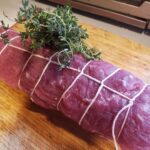 A project like this starts with some internet research. Recipes abound, but the real treasures are the how-to videos. They’re full of tips and tricks that visualize the method. Watching a pro do it is invaluable guidance to a first-timer like me. I generally look at several and pick one that seems the clearest. For my Wellington, Tasty.co had a clear recipe and a well explained YouTube video. For reference I also looked at the NYTimes.com recipe (no video) which was similar enough to give me confidence.
A project like this starts with some internet research. Recipes abound, but the real treasures are the how-to videos. They’re full of tips and tricks that visualize the method. Watching a pro do it is invaluable guidance to a first-timer like me. I generally look at several and pick one that seems the clearest. For my Wellington, Tasty.co had a clear recipe and a well explained YouTube video. For reference I also looked at the NYTimes.com recipe (no video) which was similar enough to give me confidence.
First I cut a couple steaks off the big end of the tenderloin and trimmed off the tail leaving a nice, evenly shaped roast that would cook to a consistent doneness. Following the video, I tied it to maintain the shape while browning.
Next the mushroom duxelles – finely-chopped mushrooms that are slow-cooked with bacon and shallots to remove all the moisture and develop rich color and flavor. I cooked the recommended amount, but later on, wished I had more. Be generous. If you have too much, it’s great in lasagna.
With the duxelles cooling, I cranked up the heat and quickly seasoned and seared the meat, browning but not cooking it. Fresh from the pan, the string was cut off and the entire roast brushed with mustard. Both the meat and mushrooms chilled for about an hour.
Next was the tricky part. I covered the counter with plastic wrap, wishing I had the wider commercial stuff. On that I laid out overlapping slices of prosciutto (a barrier between the moist interior and the 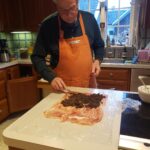 pastry) and then covered that with the duxelles. There was some measuring involved to match up the roast with the wrap. Then using the plastic wrap I rolled the ham and mushrooms around the beef, pulling it tight and twisting the ends to snug it all together like a sausage. This is where the video was an essential aid.
pastry) and then covered that with the duxelles. There was some measuring involved to match up the roast with the wrap. Then using the plastic wrap I rolled the ham and mushrooms around the beef, pulling it tight and twisting the ends to snug it all together like a sausage. This is where the video was an essential aid.
The whole thing, tight in its plastic casing, rested overnight in the refrigerator. I took a nap.
Day two is pastry and baking day. Thank heavens for frozen puff pastry. Thaw and use, no complicated prep process for the dough. I found myself reaching back to middle-school geometry to get the size right.  Roll up the prepared roast in the pastry and tightly snug it in fresh plastic wrap. Chill until ready to bake.
Roll up the prepared roast in the pastry and tightly snug it in fresh plastic wrap. Chill until ready to bake.
Marsha braided some extra dough and cut a few stars to jazz up the top. Brushed on egg wash ensured a golden-brown shine.
The baking time is tricky. The thickness of the pastry has to correlate with the size of the roast to have both done at the same time. I made the mistake of putting a tray of potatoes on the oven’s top shelf. Apparently this restricted the flow of heat and kept the pastry from browning on top. 125 was the target temperature for the meat but I let it go a little past to brown the crust.
Everyone at the table was impressed – clean plates all around. Served with a well-aged Grand-Cru Bordeaux, the eating was just as satisfying as the making. The meat was a tad overdone, and the crust a bit under, still I was pleased and counted it as a win.



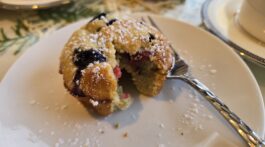




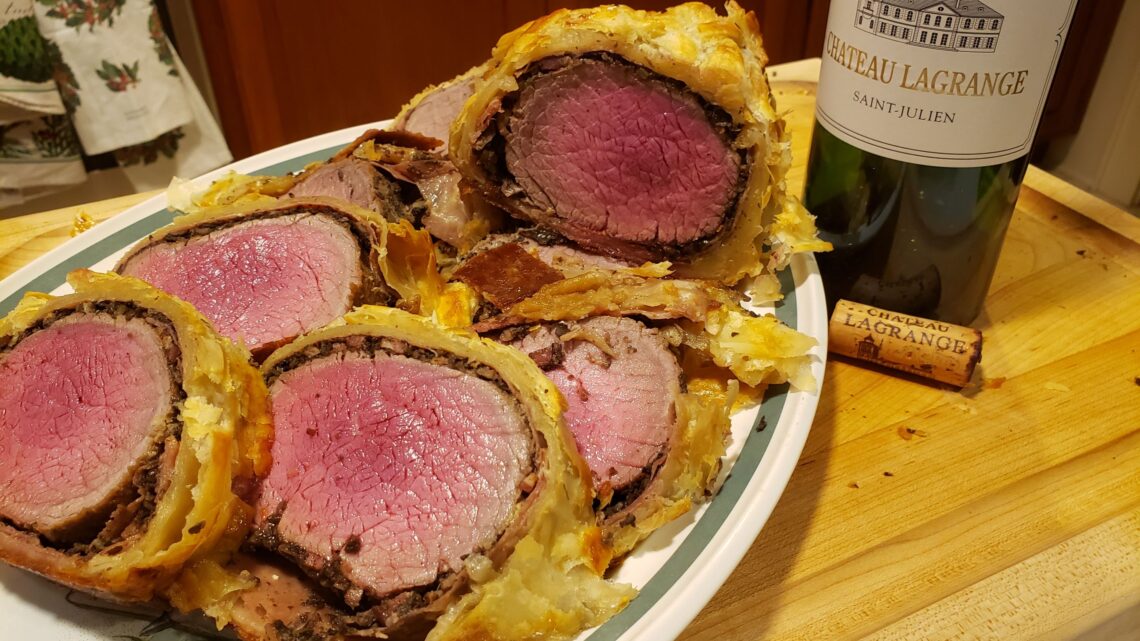
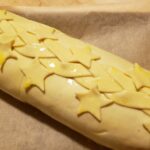

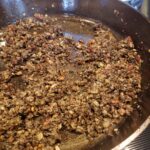
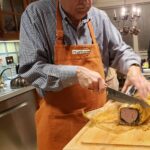

Frank,
This Beef Wellington looks mouth-watering. It’s one of my favorites and for many years I used to make it for New Years Eve. That was a long time ago and I haven’t had the courage to try it again! Julie